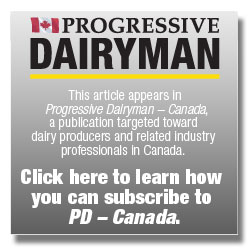Editor’s note: The following commentary is in response to the article “Use an index to help you rethink lameness prevention,” written by Vic Daniel and published in the March 21, 2012 issue of Progressive Dairyman. Click here to read more about this topic. In the 1980s Karen Mortensen, a Danish researcher, introduced the concept of lameness being a “multifactorial problem.” That theme, I suggest, is the same as the recently published article by Vic Daniel, which was thought-provoking and timely. Stress Daniel’s article reminds us that lameness does not have just one cause, but is initiated by a number of different interrelated factors.
He points out, oh, so very rightly, that the contemporary move to systematically record a herd’s foot lesions will eventually lead to solutions to our problems. He mentions “stress” as an important factor and takes the term seriously.
I know other learned colleagues who, at the mention of the same word, will smile, nod their head and pay lip service to the idea of cows having “feelings.” In my opinion, cows do have feelings, instincts and even emotions; however, they just do not equate to human comparison. Reducing stress in the dairy herd is what lameness prevention will have to come to in the end.
Genetics
The use of cowside data recorders gained attention when the Swedish research team, led by Christer Bergsten, adopted them. They were trying to use the data to produce a bull lameness index. The idea was that the index would allow dairy producers one day to be able to select bulls that produce offspring less susceptible to lameness.
In North America, I believe there may be too many vested interests for this to become popular, unless commercial dairy producers get right behind the movement. Alberto Brizzi, an Italian veterinarian who runs an exclusively lameness-oriented practice, told me we will never master lameness until we can manage the genetics.
Environment
Another potential value of lesion recording is that correlations will be found between the prevalence of lesions and their “risk factors,” which may exist both in the cows’ immediate environment and in the way she is managed. This is not a new idea. Researchers at the University of Bristol in the United Kingdom have been testing this for years.
I sympathize entirely with Daniel’s gallant effort to bang the drum and draw dairy producers’ attention to the economic losses caused by lameness. Esselmont and Spincer wrote a report published in 1993 based on their DAISY herd records that came up with much of the same information. Twenty years later, and many still do not believe.
Sole shedding
In the very early 1950s, as a young veterinarian in England, I attended to dairy cows that spent their entire lives on lush pasture. Milkers went out to the field in smocks with a three-legged stool and a bucket to milk the animals where they stood.
I was treating dozens of lame cows in those days, and it was common to see layers of horn flaking away, exposing white, powdery dust, or pith, beneath. Early in his paper Vic mentions “sole shedding” and its impact on trimming and hoof health. I just wonder how many producers know what he is talking about.
I have spoken with Ladd Siebert on the matter of sole shedding and mulled over his theories. From the hodgepodge of papers I have read, I recall that research on the tubules of the sole have been demonstrated to absorb moisture from the outside by means of capillary attraction.
This process, it is postulated, affects the moisture content of the sole and hence its flexibility, leading to the possibility of bruising of the corium, which undoubtedly leads to increased susceptibility to precipitating laminitis.
What if hoof trimmers were able to spray or paint soles with a rapid-drying varnish that would permeate the tubules by capillary attraction, making them less susceptible to moisture? In truth, academic researchers shun such mundane ideas.
We know a great deal about the molecular biology of the chemical cascade leading to laminitis, but there is so much simple stuff we do not know. For example, at what age does a heifer’s claw cease to increase in volume? Is there a correlation between the age at which a heifer calves for the first time and her longevity, relative to her claw size?
Daniel’s paper showcases thinking outside the box. Producers looking for more than just a simple answer to lameness should consider his thoughts and other multifactorial lameness causes. PD
Greenough graduated from the Royal Veterinary College in London, England in 1947. For the next 19 years he worked with dairy cattle in west England, taking a special interest in bovine lameness, for which study he was appointed a fellow of the Royal College of Veterinary Surgeons. In 1966 he jointed the faculty of the Western College of Veterinary Medicine in Saskatchewan. He has written or co-authored four books on cattle lameness as well as several chapters on the same subject in other books. Since retirement in 1992, he has lectured extensively in many parts of the world both to dairy producers and veterinarians. His most recent book was published in 2007 titled: Bovine Laminitis and Lameness: A hands-on Approach.





